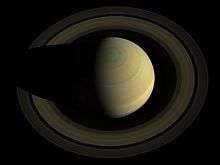Outer planets
The outer planets are those planets in the Solar System beyond the asteroid belt, and hence refers to the gas giants, which are in order of their distance from the Sun:
- Jupiter is the largest planet in the Solar System. It has four very large satellites (moons).
- Saturn is the second-largest planet, with a large and bright ring system.
- Uranus is the third-largest planet and the least massive of the four outer planets.[1] It is tilted almost onto the plane of its orbit.
- Neptune is the fourth-largest planet, as smallest of the four outer planets, but third-most massive. It has one big retrograde moon and many small ones.
The outer planets all have ring systems, although all but Saturn's are faint when viewed from Earth.[1]
Another aspect common to the gas giants is their many natural satellites (moons), two of which are larger than the planet Mercury (Jupiter's Ganymede and Saturn's Titan). That pair and Io, Callisto, Europa, and Triton, are larger than Pluto and Eris.
This region of space is also occupied by centaurs, various fields of trojans, and many comets.
Pluto was considered to be an outer planet from its discovery in 1930 until its reclassification as a dwarf planet in 2006 (see also: Kuiper belt).
Exploration

In situ exploration by spacecraft includes Pioneer 10, Pioneer 11, Voyager 1, Voyager 2, Ulysses, Galileo, Cassini–Huygens, and New Horizons. Planned missions include Juno Jupiter Orbiter and possibly the Outer Planet Flagship Missions; there are various proposals too, such as Uranus orbiter and probe. Ongoing missions for the outer planets as of 2011 include Cassini probe, orbiting Saturn, New Horizons, headed for Pluto, and Juno, headed for Jupiter. Cassini and New Horizons also visited Jupiter with a flyby.
One of the breakthroughs that made exploration of the outer planets much easier, was the concept of the planetary gravity assist.[2] Discovered in the 1960s, a spacecraft approaches a planet like Jupiter in such a way as to be accelerated to a higher speed. This allows a much smaller rocket to be used for a given launch.[2]
Another promising technology, tested on Deep Space 1, is the ion engine. Ion engines can make much more efficient use of propellant than existing chemical rockets.[2]
| Spacecraft | Launch Year |
Jupiter | Saturn | Uranus | Neptune | End Year |
|---|---|---|---|---|---|---|
| Pioneer 10 | 1972 | flyby | 2003 | |||
| Pioneer 11 | 1973 | flyby | flyby | 1995 | ||
| Voyager 1 | 1977 | flyby | flyby | — | ||
| Voyager 2 | 1977 | flyby | flyby | flyby | flyby | — |
| Galileo | 1989 | orbiter | 2003 | |||
| Galileo Probe | 1989 | entry | 1995 | |||
| Ulysses | 1990 | flyby | 2009 | |||
| Cassini | 1997 | flyby | orbiter | — | ||
| New Horizons | 2006 | flyby | — | |||
| Juno | 2011 | orbiter | — |
Mission concepts


List of mission concepts:
- Argo[3] - Jupiter, Saturn, Neptune, Kuiper belt flyby
- AVIATR (Titan Airplane)[4]
- Chiron Orbiter Mission Concept Study[5]
- Enceladus Flyby & Sample Return Concept Studies[5]
- Enceladus Orbiter Concept Study[5]
- Europa Flyby[6]
- Europa Flyby Study[7]
- Europa Lander[6]
- Europa Lander Study[7]
- Europa Orbiter[6]
- Exploration of Jovian Atmosphere Using Nuclear Ramjet Flyer[8]
- Ganymede Orbiter Concept Study[5]
- Io Observer Concept Study[5]
- Journey to Enceladus and Titan (JET)[9]
- Jupiter Europa Orbiter Study[5]
- Life Investigation For Enceladus (LIFE) - flyby sample return for Enceladus and Saturn's E-ring.[10]
- Neptune-Triton-Kuiper Belt Objects Mission Concept Study[5]
- Saturn Atmospheric Entry Probe Study[5]
- Saturn Ring Observer Concept Study[5]
- Titan Lake Probe Concept Study[5]
- Titan Saturn System Mission[5]
- Titan Rover[11]
- Trojan Tour Concept Study[5]
- Uranus and Neptune Orbiter and Probe Concept Studies[5]
- Uranus orbiter and probe
- Uranus Pathfinder[12]
See also
| Wikimedia Commons has media related to |
- Discovery and exploration of the Solar System
- Giant planets of the Solar System:
- Jupiter (moons – rings – exploration)
- Saturn (moons – rings – exploration)
- Uranus (moons – rings – exploration)
- Neptune (moons – rings – exploration)
- Kuiper belt
- List of missions to the outer planets
- Oort cloud
References
- 1 2 "How big is Neptune? - space.com". Space.com. 2015. Retrieved 2016-04-04. The 2nd-largest planet is Saturn, 3rd-largest is Uranus, 4th-largest is Neptune, while 2nd-most massive planet is Saturn, 3rd-most massive is Neptune, but 4th-most massive is Uranus.
- 1 2 3 Basics of Spaceflight - Chapter 4. Interplanetary Trajectories
- ↑ Argo - A Voyage Through the Outer Solar System
- ↑ AVIATR
- 1 2 3 4 5 6 7 8 9 10 11 12 13 Planetary Science Decadal Survey Mission & Technology Studies
- 1 2 3 March 2012 OPAG Meeting
- 1 2 OPAG
- ↑ G. Maise - Exploration of Jovian Atmosphere Using Nuclear Ramjet Flyer
- ↑ JET - Cost Capped Titan-Enceladus Proposal
- ↑ Tsou, et al. - LIFE link courtesy of Future Planetary Exploration
- ↑ ARPS Enabled Titan Rover Concept with Inflatable Wheels
- ↑ Uranus Pathfinder
Further reading
- Solar Power for Outer Planets Study (2007) – NASA Glenn Research Center
- Human Outer Planet Exploration (2003) – NASA Langley Research Center and Princeton University
- Future Exploration of the Outer Planet Satellites: A Decadal Perspective (2009)
External links
- Outer Planets Assessment Group (NASA)
- U.S. Centennial of Flight Commission - Exploration of the Outer Planets
- Space Probes to the Outer Planets
